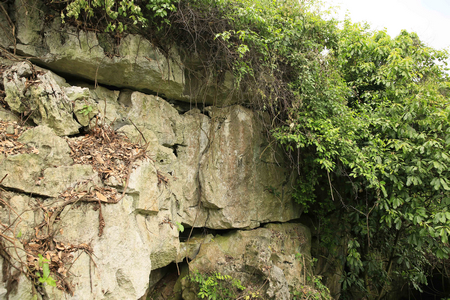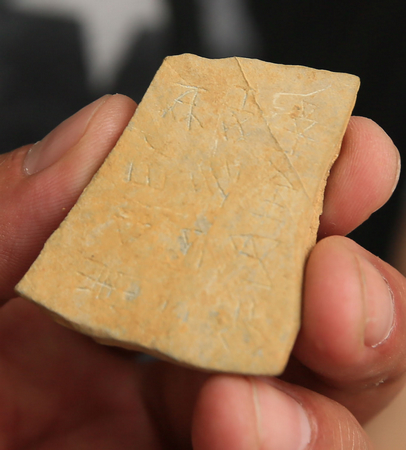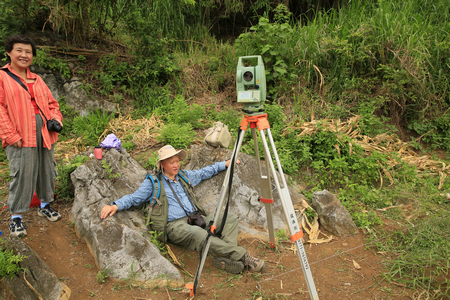Thinking about the Sites in Pingguo county, S China
From:Chinese Archaeology NetWriter:He NuDate:2014-07-02
In April 2014, Dr. Sheldon Lee Gosline proclaimed that he had found several megalithic sites including observatories, palaces, and ancient cave tombs,petro-glyphs and even plan maps at Gansang, Nadou, and Bupeng in Pingguo county, Guangxi of South China, during his survey on the stone writing planks from Gansang. He believed there was a megalithic civilization in Youjiang River Reach, which completely vanished in our documents and knowledge. In the middle of this May, Gosline was introduced to me by Prof. Wei Jian from Renmin University. Gosline introduced me about what he had found in Pingguo county with ppt presentation. I was truly got shock, and really interest in it. So Gosline and I planed to survey those sites around June 21, 2014, the summer solstice of this year.
In early of this June, Prof. Wei Jian organized a conference entitled as “The Academic Conference on the Study of Archaeo-astronomic Alignments at Gansang Area in Pingguo County, Guangxi”. Prof. Wei invited me, Dr. Wanghui, Dr. Ye Xiaohong from IA CASS, and Prof. Xu Fengxian from the Institute of Natural Science History of Chinese Academy of Science, to form an archaeological team, participating the survey and discussion.
On June 21, the team arrived at Pingguo county. From 22 to 23, we surveyed the sites of Gansang, Nadou, Bupeng, measured the potential alignments at Gansang site with Total Station. In the museum of Pingguo County, we also checked the artifacts excavated from Gansang site, and the stone writing planks collected from it. On 24th, we visited Dashitan Site, a ceremonial site with Ritual Shovels.
Based on the surveys in these days and common senses of Chinese archaeology and archaeo-astronomy, on the behalf of the team, I conclude some initial considerations about this survey.
I. We have not found any artificial remains, artifacts, and occupation layer both at Nadou and Bupeng sites. They could not be identified as archaeological sites (Fig.1, Fig.2). Without any archaeological data and past settlement support, the so-called structures for observation are hardly identified. Dr. Wanghui from the team will detail such issue.

Fig. 1. Natural Sediments of Limestone at Nadou site


Fig. 2. Natural Rock at Bupeng site
II. Two “Cave Tombs” are merely the natural caves, other than the graves.
III. Most of scratches, the petro-glyphs and plan maps on the rocks called by Gosline, are natural. Only few of them look like artificially, should be analyzed with microscope in order to identify what kind of tools were used. Dr. Ye Xiaohong form the team will talk about such strategy.
IV. Gansang Site should be considered as the target of historical heritage archaeology at Pingguo County.
1. Consideration of Gansang Site
Covering an area of 15-20 ha, Gansang site might have worked as an important settlement in Youjiang River Reach. It is embraced with hills, serving as a natural fortification (Fig.3). It could be considered as a walled-town without enclosure and moat. We suggest that the future archaeological work will firstly focus on its chronology, to see what the earliest time the site could be retraced. Then a settlement pattern research can be conducted on it, in order to figure out its functional district arrangements, social organization and hierarchy.

Fig. 3 Landscape of Gansang Site
2. The problems about the stone planks carved with characters

Fig. 4 Stone Planks carved with characters collected from Gansang
The stone planks carved with characters from Gansang site have six critical problems. Firstly, the most of intersection point of the carving panel are too new to be convincible (Fig.4). Secondly, contrary to potsherds with glyphs of Longshan period (Late Neolithic Culture of China) and oracle bones inscriptions of Shang Dynasty, the stone planks from Gansang site are too intact, namely the whole texts just fit to the sizes of the planks. Thirdly, there is no any concrete archaeological evidence to demonstrate that a single stone plank was recovered in archaeological context. Fourthly, the characters in the same text on the same plank are quite rarely repeated. Even in the texts on Sample No. 002, 003, and 004, in which there are over 100 characters engraved on them, the repeating rate of a given character is very little. In the texts on different planks, the character repeating rate exhibits very few, either. Compared to character repeating rate both of oracle bones and bronze ware inscriptions, the repeating rate of writings from Gansang site appears very weird. It seams that writers of Gansang might have not tried to inscribe a regular sentence or text, but attempted to show us the individual characters as much as possible.
According to the statistic made by local scholars, 44 planks collected from Gansang site, have produced 1028 individual characters (Ban Zhao, 2013). Fifthly, in its writing system the oracle bones inscriptions or modified ones were firstly created in 3000 years ago, oddly co-exist with Song Ti characters (宋体字) which were created in Song Dynasty (about 1000 years ago), such as不(002-03-13, Ban Zhao 2013), 示(002-03-06), 冗(002-03-12), 北(002-06-04), 太(002-11-06), 杏(003-01-09), 六(004-02-08), 从(simplified Chinese character, 004-04-07), 可(008-07-05), ¥(symbol of Renminbi, 030-02-01), and 生(up-side-down written, 034-02-02, Ban Zhao 2013). Sixthly, the most fatal problem is that the planks could not be dated precisely, so that one cannot say any more hypotheses about them. As to the tool used for engraving the characters on stone planks from Gansang site, Dr. Ye Xiaohong will discuss her technique. Based on the information what we have had, we truly doubt the truth of such carved plans from Gansang site.
According to the statistic made by local scholars, 44 planks collected from Gansang site, have produced 1028 individual characters (Ban Zhao, 2013). Fifthly, in its writing system the oracle bones inscriptions or modified ones were firstly created in 3000 years ago, oddly co-exist with Song Ti characters (宋体字) which were created in Song Dynasty (about 1000 years ago), such as不(002-03-13, Ban Zhao 2013), 示(002-03-06), 冗(002-03-12), 北(002-06-04), 太(002-11-06), 杏(003-01-09), 六(004-02-08), 从(simplified Chinese character, 004-04-07), 可(008-07-05), ¥(symbol of Renminbi, 030-02-01), and 生(up-side-down written, 034-02-02, Ban Zhao 2013). Sixthly, the most fatal problem is that the planks could not be dated precisely, so that one cannot say any more hypotheses about them. As to the tool used for engraving the characters on stone planks from Gansang site, Dr. Ye Xiaohong will discuss her technique. Based on the information what we have had, we truly doubt the truth of such carved plans from Gansang site.
3. Take into account of the potential observation features
The limestone supposed to be the observation point (so-called stone chair) is natural (Fig. 5), but one cannot completely reject the possibility that such structure might have been utilized by the past settlers at Gansang. Given this, the team measured a set of alignments and vertical angles of 26 peaks with total station, but it will take times to do astronomical calculation in order to figure out which peaks could be applied for observation. Prof. Xu Fengxian will explain such issue later.

Fig. 5 Potential Observation Point at Gansang
Even if the astronomic calculation of such data could figure out several meaningful alignments, it is also necessary to demonstrate such facility being used during the occupation of Gansang Site, depending on archaeological stratum. In another word, without support from archaeological evidence, only the “meaningful alignments” do not make any senses, because a random plot and any skyline of a certain mountain could compose an observation system for horizontal calendar (the positional calendar). If it has never been used by past people, however, it is meaningless.
4. Macro-settlement pattern research on Gansang Culture
After clarified the chronological date and feature of Gansang Culture, I suggest that a regional systematic survey concerning the territory of Gansang Culture and its settlement hierarchy should be carried out, taking into account of rock paintings from Zuojiang River Valley and Stone Ritual Shovels (大石铲) from Long'an, to realize the whole picture of formation, development, and structure of Gansang polity.
Reference:
Ban Zhao, 2013. The Copies and Vocabulary of Carved Characters on Stone Planks from Gansang. Science and Technology Press of Guangdong (Guangzhou).

